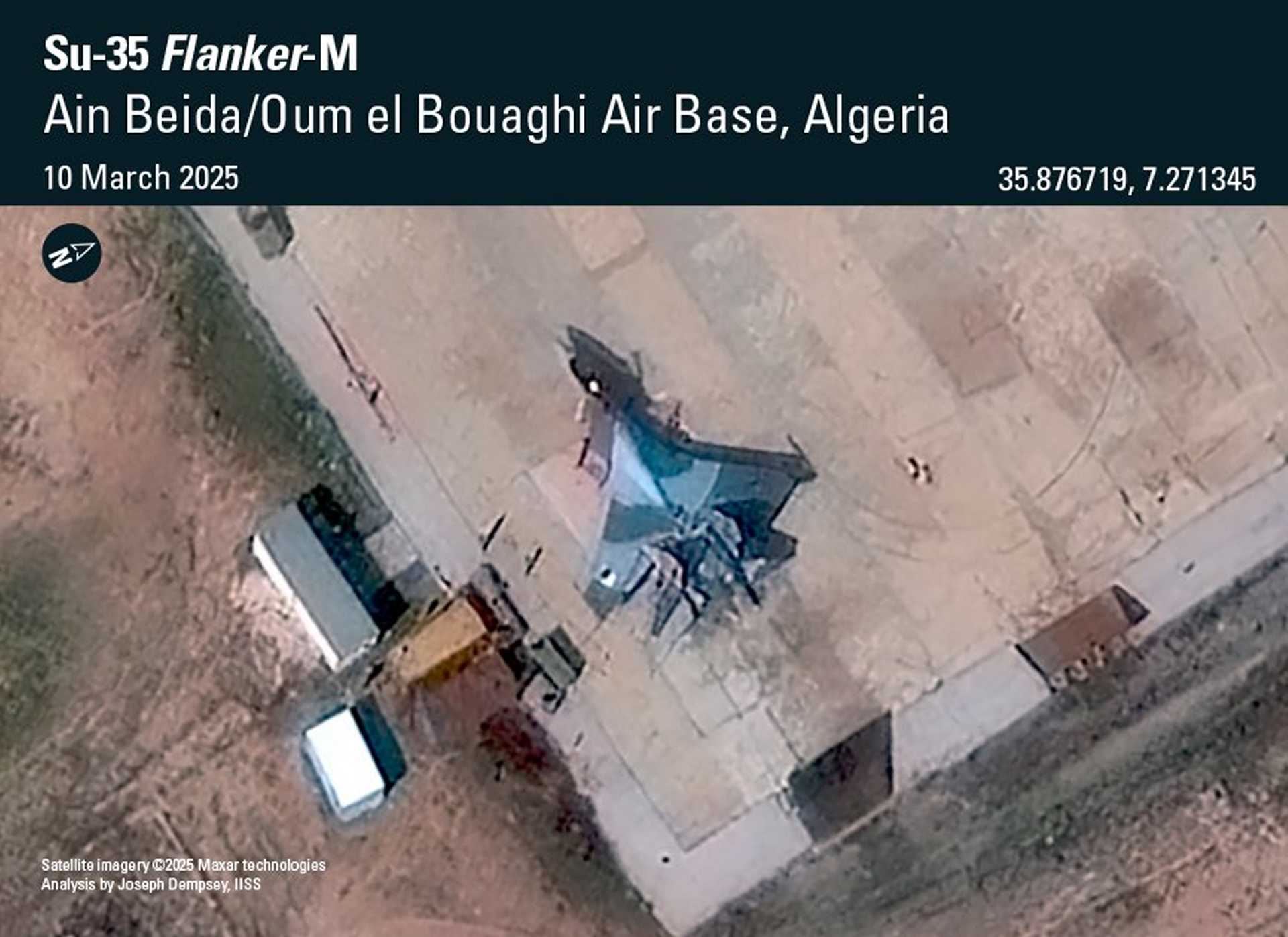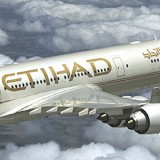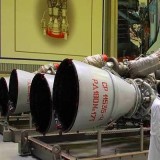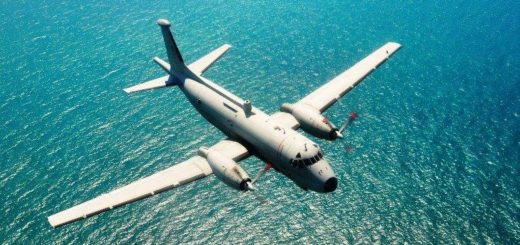Satellite imagery confirms Russia redirected at least five Su-35 fighter jets from Egypt to Algeria

{loadposition bannertop}
{loadposition sidebarpub}
As reported by the International Institute for Strategic Studies (IISS) on April 8, 2025, Algeria has begun operating the Russian-made Sukhoi Su-35 fighter aircraft, with satellite imagery captured on 10 March 2025 confirming the presence of one such aircraft at Ain Beida/Oum el Bouaghi Air Base in northeastern Algeria, a fact that we had already reported. The aircraft bears Algerian roundels on the upper port wing.Follow Army Recognition on Google News at this link
Satellite imagery captured on 10 March 2025 confirmed the presence of one Su-35 fighter jet at Ain Beida/Oum el Bouaghi Air Base in northeastern Algeria. (Picture source: IISS via Twitter/Clash Report)
This development follows earlier imagery, dated 2 March 2025, from Komsomolsk-on-Amur, showing a Russian Air Force Antonov An-124 transport aircraft preparing to load what appears to be a Flanker-series fuselage painted in a scheme consistent with the Egyptian order. The aircraft subsequently departed the site, and the same Condor was observed at Ain Beida on 5 March 2025. Additional imagery indicates that at least four more Su-35s, originally built for Egypt, have since been repainted with Algerian roundels.
These aircraft were produced at the Yuri Gagarin Komsomolsk-on-Amur facility under a 2018 order from Egypt. In 2019, the United States warned that the sale would trigger sanctions under the Countering America’s Adversaries Through Sanctions Act. Despite these warnings, production continued through 2021, with at least 12 aircraft observed on the hardstand. By 2022, the order appeared to be complete, but no deliveries took place. Egypt later withdrew from the deal under political and economic pressure. There were discussions about transferring these aircraft to Iran, but those did not initially materialize. Tehran reportedly prioritized air defense systems over additional fighter jets. Iran eventually confirmed the purchase of Su-35s in January 2025 to replace aging U.S.-made F-14 Tomcats and F-4 Phantoms, although only two deliveries of Su-35SEs have been previously reported by Army Recognition and not verified by imagery.
In Algeria, official channels have not confirmed the Su-35 acquisition. No statements have been issued by Algeria’s Ministry of National Defense or Russia’s Rosoboronexport. However, multiple sources, including satellite imagery and open-source reports, indicate that Algeria is now operating Su-35s from Ain Beida. According to reports dated 13 and 14 March 2025, the Algerian Air Force has initiated flight operations with the aircraft. It is estimated that Algeria may have received 14 of the 28 Su-35s originally produced for Egypt. Some reports suggest the aircraft may have been leased to Algeria as a stopgap measure pending delivery of the Su-57 Felon, which was confirmed by Algerian state media in February 2025.
These Su-35s were produced at the Yuri Gagarin Komsomolsk-on-Amur facility under a 2018 order from Egypt, but the country later withdrew from the deal. (Picture source: RussianPlanes.net/VVN)
The Su-57 acquisition was first reported in 2021, and Algeria was identified as the first foreign customer. Deliveries were expected by the end of 2025, but production delays have affected timelines. As of the first quarter of 2025, only 19 Su-57s had been delivered to the Russian Air Force. A 2019 contract for 76 aircraft under Russia’s State Armament Programme anticipated delivery by 2028. In 2024, the target was to reach a 16-aircraft production rate per year, though only seven aircraft were reportedly delivered in 2023–2024. United Aircraft Corporation CEO Vadim Badekha stated on 29 March 2025 that Su-57, Su-35, and Su-34 production rates would be increased.
Algeria’s acquisition of the Su-35 has been interpreted by analysts as an interim measure while awaiting Su-57 deliveries. Algeria’s Air Force currently operates over 70 Su-30MKA fighters, which form the core of its air combat fleet. The Su-30MKA is a derivative of the Su-30MKI, based on the Su-27 airframe. It includes N011M phased array radar, thrust-vectoring AL-31FP engines, and supports a payload of 8,000 kilograms. It has a maximum speed of Mach 2, a combat radius of approximately 1,500 kilometers, and can be equipped with both air-to-air and air-to-ground munitions. The aircraft has been in service since 2006 and is used for air superiority, strike, and reconnaissance missions.
The Su-35 is an evolution of the Su-27M and Su-37 programs and incorporates improvements in engine performance, avionics, and radar capabilities. Unlike the Su-30MKA and Su-37, it omits canards and relies solely on thrust-vectoring for maneuverability. The aircraft is powered by two AL-41F-1S turbofan engines, allowing speeds up to Mach 2.25 and an operational range of 3,600 kilometers. It supports 9-g maneuvering and is fitted with the Irbis-E passive electronically scanned array radar, which can detect targets at distances exceeding 350 kilometers. Some versions also include secondary AESA radars in the wing roots. The cockpit features digital glass displays, and the airframe includes lighter composite materials and reinforced structures.
Unlike the Su-30MKA and Su-37, the Su-35 Flanker-E omits canards and relies solely on thrust-vectoring for maneuverability. (Picture source: Vitaly Kuzmin)
The Su-35 has 14 external hardpoints and a payload capacity exceeding 8,000 kilograms. It is equipped with the GSh-30-1 30mm cannon and can carry R-77-1, R-73, and R-37M air-to-air missiles, as well as Kh-31 and Kh-59 cruise missiles, and KAB-500/KAB-1500 precision-guided bombs. Electronic warfare capabilities are provided by onboard jamming and countermeasure systems. The aircraft’s multirole capacity includes air superiority, interdiction, and ground strike operations. Some analysts have noted that incorporating Su-35s into the Algerian Air Force, which already operates Su-30MKAs, could increase maintenance complexity without adding fundamentally new capabilities. However, Algeria may consider upgrading its Su-30MKA fleet with Su-35 technologies, including the AL-41F-1S engines and Irbis-E radar, for logistical standardization and improved performance.
Algeria’s military aviation modernization takes place in a regional context marked by competition with Morocco, which operates F-16 Fighting Falcons. Morocco’s fleet includes approximately 23 Block 52+ aircraft, with upgrades to Block 70/72 underway. These aircraft, powered by the APG-68 radar and equipped with AIM-120 AMRAAMs, offer a combat range of 550 kilometers on internal fuel, extendable with drop tanks. In recent years, Morocco has reportedly pursued the F-35 Lightning II, with Israeli media reporting a potential deal for 32 aircraft at a cost of over $17 billion. Negotiations apparently began in 2020, with Israeli support facilitating dialogue with U.S. authorities.
Algeria’s interest in the Su-35 was initially reported in 2018, alongside discussions for Su-34 and Su-57 acquisitions. Unconfirmed reports at the time stated that Algerian pilots had tested the Su-35 in Tamanrasset in 2016. The current deliveries align with these earlier accounts. As previously reported by Army Recognition, Algeria is the third foreign operator of the Russian Su-35 after Iran and China. The possibility remains that Iran requested a customized Su-35 variant. As of now, imagery has only verified one aircraft in Algeria, though more are expected. From an operational standpoint, the Su-35’s performance in recent conflicts has influenced perceptions of its effectiveness. The aircraft has reportedly achieved a high number of air-to-air kills in the Russia–Ukraine conflict and participated in major engagements. This includes the use of the R-37M and R-77M missiles, which may also be introduced into the Algerian Air Force alongside the Su-35.
The Su-35 has 14 external hardpoints and a payload capacity exceeding 8,000 kilograms, allowing it to carry R-77-1, R-73, and R-37M air-to-air missiles, as well as Kh-31 and Kh-59 cruise missiles, and KAB-500/KAB-1500 precision-guided bombs. (Picture source: Vitaly Kuzmin)
The introduction of Su-35s into Algeria’s fleet may also influence regional procurement decisions. Tensions with Morocco over the Western Sahara continue to shape defense policies. France and the United States, both with strategic interests in the Mediterranean, are closely monitoring developments. A March 2025 incident involving a Russian Su-35 intercepting a French MQ-9 Reaper drone over the Mediterranean was reported, and highlighted the broader regional implications of the aircraft’s deployment.
Algeria’s airspace defense requirements are shaped by its 2,400-kilometer coastline and borders with seven countries, including Libya and Mali. The operational range, radar coverage, and weapon systems of the Su-35 may support border surveillance and counterterrorism operations, particularly in the Sahel region. Training programs for Algerian pilots in Russia have been reported but not officially confirmed. The long-term role of the Su-35 in Algeria’s force structure remains uncertain. It is not yet clear whether the aircraft will replace older platforms such as the MiG-25 and MiG-29, or expand the overall fleet size.
The lack of official confirmation regarding the Su-35 acquisition is consistent with Algeria’s traditional approach to arms procurement. The country has historically maintained discretion in announcing military deals, especially amid sensitive geopolitical dynamics. According to Agenzia Nova, General Said Chengriha was reportedly involved in aircraft acquisition talks as recently as February 2025, but no further details have been released. The broader implications of this development for North Africa’s military balance will depend on additional deliveries and future defense procurement decisions in the region. While the Su-35 offers improvements in range, radar, and payload over Algeria’s current aircraft, its integration poses logistical and strategic considerations that remain unresolved.

{loadposition bannertop}
{loadposition sidebarpub}
As reported by the International Institute for Strategic Studies (IISS) on April 8, 2025, Algeria has begun operating the Russian-made Sukhoi Su-35 fighter aircraft, with satellite imagery captured on 10 March 2025 confirming the presence of one such aircraft at Ain Beida/Oum el Bouaghi Air Base in northeastern Algeria, a fact that we had already reported. The aircraft bears Algerian roundels on the upper port wing.
Follow Army Recognition on Google News at this link
Satellite imagery captured on 10 March 2025 confirmed the presence of one Su-35 fighter jet at Ain Beida/Oum el Bouaghi Air Base in northeastern Algeria. (Picture source: IISS via Twitter/Clash Report)
This development follows earlier imagery, dated 2 March 2025, from Komsomolsk-on-Amur, showing a Russian Air Force Antonov An-124 transport aircraft preparing to load what appears to be a Flanker-series fuselage painted in a scheme consistent with the Egyptian order. The aircraft subsequently departed the site, and the same Condor was observed at Ain Beida on 5 March 2025. Additional imagery indicates that at least four more Su-35s, originally built for Egypt, have since been repainted with Algerian roundels.
These aircraft were produced at the Yuri Gagarin Komsomolsk-on-Amur facility under a 2018 order from Egypt. In 2019, the United States warned that the sale would trigger sanctions under the Countering America’s Adversaries Through Sanctions Act. Despite these warnings, production continued through 2021, with at least 12 aircraft observed on the hardstand. By 2022, the order appeared to be complete, but no deliveries took place. Egypt later withdrew from the deal under political and economic pressure. There were discussions about transferring these aircraft to Iran, but those did not initially materialize. Tehran reportedly prioritized air defense systems over additional fighter jets. Iran eventually confirmed the purchase of Su-35s in January 2025 to replace aging U.S.-made F-14 Tomcats and F-4 Phantoms, although only two deliveries of Su-35SEs have been previously reported by Army Recognition and not verified by imagery.
In Algeria, official channels have not confirmed the Su-35 acquisition. No statements have been issued by Algeria’s Ministry of National Defense or Russia’s Rosoboronexport. However, multiple sources, including satellite imagery and open-source reports, indicate that Algeria is now operating Su-35s from Ain Beida. According to reports dated 13 and 14 March 2025, the Algerian Air Force has initiated flight operations with the aircraft. It is estimated that Algeria may have received 14 of the 28 Su-35s originally produced for Egypt. Some reports suggest the aircraft may have been leased to Algeria as a stopgap measure pending delivery of the Su-57 Felon, which was confirmed by Algerian state media in February 2025.

These Su-35s were produced at the Yuri Gagarin Komsomolsk-on-Amur facility under a 2018 order from Egypt, but the country later withdrew from the deal. (Picture source: RussianPlanes.net/VVN)
The Su-57 acquisition was first reported in 2021, and Algeria was identified as the first foreign customer. Deliveries were expected by the end of 2025, but production delays have affected timelines. As of the first quarter of 2025, only 19 Su-57s had been delivered to the Russian Air Force. A 2019 contract for 76 aircraft under Russia’s State Armament Programme anticipated delivery by 2028. In 2024, the target was to reach a 16-aircraft production rate per year, though only seven aircraft were reportedly delivered in 2023–2024. United Aircraft Corporation CEO Vadim Badekha stated on 29 March 2025 that Su-57, Su-35, and Su-34 production rates would be increased.
Algeria’s acquisition of the Su-35 has been interpreted by analysts as an interim measure while awaiting Su-57 deliveries. Algeria’s Air Force currently operates over 70 Su-30MKA fighters, which form the core of its air combat fleet. The Su-30MKA is a derivative of the Su-30MKI, based on the Su-27 airframe. It includes N011M phased array radar, thrust-vectoring AL-31FP engines, and supports a payload of 8,000 kilograms. It has a maximum speed of Mach 2, a combat radius of approximately 1,500 kilometers, and can be equipped with both air-to-air and air-to-ground munitions. The aircraft has been in service since 2006 and is used for air superiority, strike, and reconnaissance missions.
The Su-35 is an evolution of the Su-27M and Su-37 programs and incorporates improvements in engine performance, avionics, and radar capabilities. Unlike the Su-30MKA and Su-37, it omits canards and relies solely on thrust-vectoring for maneuverability. The aircraft is powered by two AL-41F-1S turbofan engines, allowing speeds up to Mach 2.25 and an operational range of 3,600 kilometers. It supports 9-g maneuvering and is fitted with the Irbis-E passive electronically scanned array radar, which can detect targets at distances exceeding 350 kilometers. Some versions also include secondary AESA radars in the wing roots. The cockpit features digital glass displays, and the airframe includes lighter composite materials and reinforced structures.

Unlike the Su-30MKA and Su-37, the Su-35 Flanker-E omits canards and relies solely on thrust-vectoring for maneuverability. (Picture source: Vitaly Kuzmin)
The Su-35 has 14 external hardpoints and a payload capacity exceeding 8,000 kilograms. It is equipped with the GSh-30-1 30mm cannon and can carry R-77-1, R-73, and R-37M air-to-air missiles, as well as Kh-31 and Kh-59 cruise missiles, and KAB-500/KAB-1500 precision-guided bombs. Electronic warfare capabilities are provided by onboard jamming and countermeasure systems. The aircraft’s multirole capacity includes air superiority, interdiction, and ground strike operations. Some analysts have noted that incorporating Su-35s into the Algerian Air Force, which already operates Su-30MKAs, could increase maintenance complexity without adding fundamentally new capabilities. However, Algeria may consider upgrading its Su-30MKA fleet with Su-35 technologies, including the AL-41F-1S engines and Irbis-E radar, for logistical standardization and improved performance.
Algeria’s military aviation modernization takes place in a regional context marked by competition with Morocco, which operates F-16 Fighting Falcons. Morocco’s fleet includes approximately 23 Block 52+ aircraft, with upgrades to Block 70/72 underway. These aircraft, powered by the APG-68 radar and equipped with AIM-120 AMRAAMs, offer a combat range of 550 kilometers on internal fuel, extendable with drop tanks. In recent years, Morocco has reportedly pursued the F-35 Lightning II, with Israeli media reporting a potential deal for 32 aircraft at a cost of over $17 billion. Negotiations apparently began in 2020, with Israeli support facilitating dialogue with U.S. authorities.
Algeria’s interest in the Su-35 was initially reported in 2018, alongside discussions for Su-34 and Su-57 acquisitions. Unconfirmed reports at the time stated that Algerian pilots had tested the Su-35 in Tamanrasset in 2016. The current deliveries align with these earlier accounts. As previously reported by Army Recognition, Algeria is the third foreign operator of the Russian Su-35 after Iran and China. The possibility remains that Iran requested a customized Su-35 variant. As of now, imagery has only verified one aircraft in Algeria, though more are expected. From an operational standpoint, the Su-35’s performance in recent conflicts has influenced perceptions of its effectiveness. The aircraft has reportedly achieved a high number of air-to-air kills in the Russia–Ukraine conflict and participated in major engagements. This includes the use of the R-37M and R-77M missiles, which may also be introduced into the Algerian Air Force alongside the Su-35.

The Su-35 has 14 external hardpoints and a payload capacity exceeding 8,000 kilograms, allowing it to carry R-77-1, R-73, and R-37M air-to-air missiles, as well as Kh-31 and Kh-59 cruise missiles, and KAB-500/KAB-1500 precision-guided bombs. (Picture source: Vitaly Kuzmin)
The introduction of Su-35s into Algeria’s fleet may also influence regional procurement decisions. Tensions with Morocco over the Western Sahara continue to shape defense policies. France and the United States, both with strategic interests in the Mediterranean, are closely monitoring developments. A March 2025 incident involving a Russian Su-35 intercepting a French MQ-9 Reaper drone over the Mediterranean was reported, and highlighted the broader regional implications of the aircraft’s deployment.
Algeria’s airspace defense requirements are shaped by its 2,400-kilometer coastline and borders with seven countries, including Libya and Mali. The operational range, radar coverage, and weapon systems of the Su-35 may support border surveillance and counterterrorism operations, particularly in the Sahel region. Training programs for Algerian pilots in Russia have been reported but not officially confirmed. The long-term role of the Su-35 in Algeria’s force structure remains uncertain. It is not yet clear whether the aircraft will replace older platforms such as the MiG-25 and MiG-29, or expand the overall fleet size.
The lack of official confirmation regarding the Su-35 acquisition is consistent with Algeria’s traditional approach to arms procurement. The country has historically maintained discretion in announcing military deals, especially amid sensitive geopolitical dynamics. According to Agenzia Nova, General Said Chengriha was reportedly involved in aircraft acquisition talks as recently as February 2025, but no further details have been released. The broader implications of this development for North Africa’s military balance will depend on additional deliveries and future defense procurement decisions in the region. While the Su-35 offers improvements in range, radar, and payload over Algeria’s current aircraft, its integration poses logistical and strategic considerations that remain unresolved.





